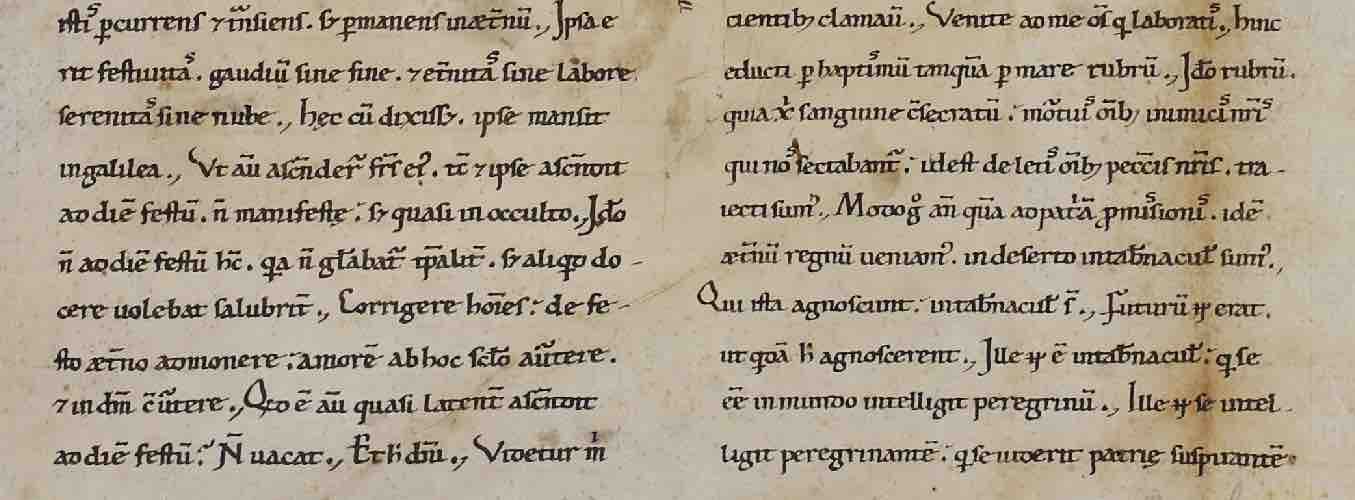Transcribe
Latin Visigothic and Beneventan - Transcription

Description
The scripts of Spain and southern Italy in the central and high Middle Ages.
Introduction
Remember in Visigothic script
- The a and u in this script, as in many of the early medieval minuscules, are very easy to mistake for one another.
- Remember that the letter g, which looks like a c with a very long tail. Like a c, it is open at the right. The form resembles the Uncial g in ductus.
- T can join with preceding or following letters, and can take several different forms depending on the ligature. It is easy to mistake t for a or c or e, depending on context.
- Scribes writing Visigothic use two forms of t-iligature: ti with an i that stands on the line represents "hard" t + i, whereas tj, with an elongated, j-like i is used where the t is assibilated – where it has the sound "ts-". Visigothic also uses a tall i (i-longa), which stands on the baseline and looks like it could be a lowercase l. I-longa is used at the beginnings of words (unless anther tall letter immediately follows it) and also between vowels where it represents consonantal i (the "y" sound), as in eIus (eius).
Remember in Beneventan script
- The Beneventan script is characterized above all by the broken minim, in which the letter part that in other scripts is the smallest vertical stroke is made of two lozenge-like diagonal strokes written with a broad pen held at an angle.
- Remember that Beneventan shares several features with Visigothic: a tall e that joins in ligature with following letters; the i-longa that resembles a lower-case l; an r with a very pointy top; and a t whose headstroke curves around to the left and resembles c.
- In ligatures, the letters e, f, g, r, and t all have connecting strokes that reach out and join the following letter at minim-height.
- Beneventan also uses a variety of ligatures with i in which the i is long and curvy like a j.
Exercise 1 - Visigothic
The British Library, Add. 11695, f. 194r.
Transcribe the first eleven lines of this manuscript.
1
2
3
4
5
6
7
8
9
10
11
British Library, The Silos Apocalypse, Add. 11695, fol. 194r (http://www.bl.uk/manuscripts/FullDisplay.aspx?ref=Add_MS_11695)
Transcription Answer (Notepad )
1 Qui principes estis eius un hac ciuitate
2 singulorum officia singillatim
3 supra disseruit uel non audienda
4 hec in ea ultra disposuit;
5 Propter quam causam sic iudicetur
6 interserit in ea dixit sanguis pr(o)f(et)ar(um)
7 et s(an)c(t)or(um) inuentus est et omnium qui
8 interfecti sunt super terram;
9 EXPLICIT EXPLANATIO
10 INCIPIT /Y\STORIA
11 DE CIVITATE DEI
2 singulorum officia singillatim
3 supra disseruit uel non audienda
4 hec in ea ultra disposuit;
5 Propter quam causam sic iudicetur
6 interserit in ea dixit sanguis pr(o)f(et)ar(um)
7 et s(an)c(t)or(um) inuentus est et omnium qui
8 interfecti sunt super terram;
9 EXPLICIT EXPLANATIO
10 INCIPIT /Y\STORIA
11 DE CIVITATE DEI
Exercise 2 - Beneventan
The British Library, Add. 30337, fol. 8r
Transcribe the first ten lines of this manuscript.
1
2
3
4
5
6
7
8
9
10
British Library, The Monte Cassino Exultet Roll, Add. 30337, fol. 8r (https://www.bl.uk/manuscripts/FullDisplay.aspx?ref=Add_MS_30337)
Transcription Answer (Notepad )
1 Oramus te domine ut cereus iste in honorem nominis tui
2 consecratus. ad noctis huius caliginem destruendam
3 indeficiens perseueret. et in odorem suauitatis acceptus.´
4 supernis luminaribus misceatur .,.
5 Flammas eius lucifer matutinus inueniat. ille inquam
6 lucifer qui nesciat occasum. ille qui regressus ab inferis
7 humano generi serenus illuxit .,.
8 Precamur ergo te domine ut nos famulos tuos omnem
9 clerum et deuotissimum populum.´ Una cum beatissimo
10 papa nostro. .Et antistite nostro. .prȩsentis uitȩ
2 consecratus. ad noctis huius caliginem destruendam
3 indeficiens perseueret. et in odorem suauitatis acceptus.´
4 supernis luminaribus misceatur .,.
5 Flammas eius lucifer matutinus inueniat. ille inquam
6 lucifer qui nesciat occasum. ille qui regressus ab inferis
7 humano generi serenus illuxit .,.
8 Precamur ergo te domine ut nos famulos tuos omnem
9 clerum et deuotissimum populum.´ Una cum beatissimo
10 papa nostro. .Et antistite nostro. .prȩsentis uitȩ